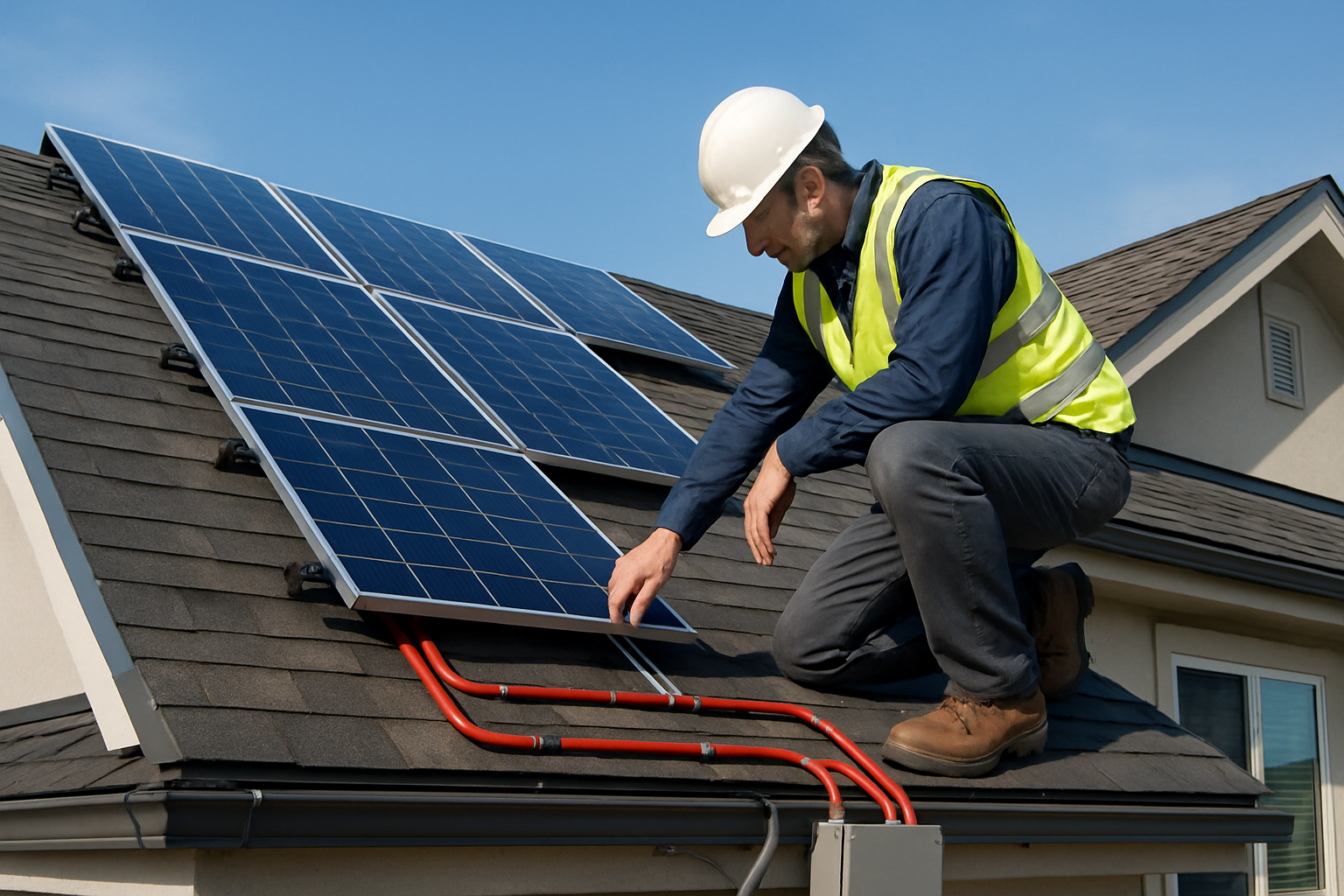The solar energy sector is experiencing remarkable growth, with significant increases in installed capacity across the globe. For instance, China alone added over 100 GW of solar PV capacity in 2022, and annual installations grew by 40% or more in Europe, India, and Brazil. This rapid expansion underscores solar power's role in achieving energy independence and sustainability. However, realizing these benefits depends on more than just advanced technology; it requires meticulous adherence to regulatory processes. Navigating solar permit submittals and inspections can be complex, and overlooking crucial details often leads to expensive delays, rework, and even project rejection. This guide outlines seven common pitfalls and offers practical advice to help you achieve seamless solar installations.

The Critical Role of Solar Permits and Inspections
Why Permits Matter for Solar Installations
Permits and inspections serve as safeguards, ensuring that every solar installation meets established safety standards and local building codes. They protect homeowners from improperly installed systems and ensure the longevity and efficiency of the solar investment. Without proper approval, an installation can face legal challenges, fines, or even require removal, negating the environmental and economic benefits you seek.
Navigating the Approval Landscape
The approval process for solar projects can be a significant concern for investors and financiers. While some locations allow solar systems to be installed without permits, or with free permits, this typically excludes historical buildings. Understanding these varying requirements and preparing for them is key to a smooth process. Clear rules on permitting are essential to encourage private investment in the renewable energy sector.
Mistake 1: Incomplete or Inaccurate Documentation
The Pitfall of Missing Information
One of the most frequent reasons for permit rejections is submitting incomplete or inaccurate documentation. This includes missing structural calculations, outdated electrical diagrams, or site plans that do not reflect current conditions. Each piece of missing information creates delays, as authorities must request revisions, prolonging the approval timeline.
Best Practices for Comprehensive Submittals
Always use a detailed checklist to ensure every required form, drawing, and specification is included. Verify that all details, from panel layout to inverter models and battery storage system specifications, align precisely with your proposed installation. For instance, if you are integrating a home energy storage system with LiFePO4 batteries, ensure all battery specifications, safety data sheets, and installation guidelines are part of the submittal package.
Mistake 2: Ignoring Local Building Codes and Zoning Regulations
The Consequences of Non-Compliance
Building codes and zoning regulations vary significantly by location, even within the same country. Legal barriers vary greatly from country to country, and often follow lower territorial divisions. Failure to comply can lead to failed inspections, substantial fines, or the costly requirement to modify or remove parts of the installation. This applies to structural integrity, electrical standards, and even aesthetic considerations.
Proactive Code Research
Before designing your system, thoroughly research all applicable local building codes, fire codes, and zoning ordinances. Pay close attention to roof safety standards, setback requirements, and specific mounting guidelines for solar panels. This research is especially important for off-grid solar solutions, which may have unique considerations related to energy storage and backup power.
Mistake 3: Underestimating Structural Requirements
Overlooking Roof Load Capacity
Solar panels add weight to a roof, and neglecting to assess the existing structure's load-bearing capacity can lead to serious safety hazards. An overloaded roof risks structural failure, particularly under additional stress from snow or high winds. This oversight can compromise the entire building and the solar investment.
Ensuring Roof Integrity for Solar Panels
Always obtain a professional structural engineering assessment of the roof. This assessment should account for the dead load of the solar array, as well as potential live loads from snow and wind, specific to your geographic location. Ensuring the roof can safely support the system is fundamental for the long-term reliability of your solar energy solution, including integrated battery storage.
Mistake 4: Electrical Diagram Errors and Inconsistencies
The Dangers of Faulty Wiring Schematics
Electrical diagrams are the backbone of your solar installation's safety and functionality. Errors in these schematics, such as incorrect wire sizing, improper grounding, or mislabeled components, pose significant electrical hazards, risk system malfunctions, and can even cause fires. These mistakes are often caught during inspection, leading to immediate failure.
Precision in Electrical Design
Submit accurate and clear electrical diagrams, including single-line and three-line diagrams. Detail all equipment specifications, including solar inverters and LiFePO4 battery systems, ensuring they meet relevant electrical codes like the National Electrical Code (NEC). Double-check all connections, conductor sizes, overcurrent protection, and grounding to ensure a safe and compliant system.
Mistake 5: Neglecting Fire Safety Regulations
The Importance of Clearances and Access
Fire safety regulations are paramount for rooftop solar installations. These rules often dictate specific setbacks from roof edges, ridges, and valleys to ensure firefighters have safe access and clear pathways. Rapid shutdown requirements for PV systems are also critical, allowing emergency responders to de-energize the array quickly.
Designing for Fire Safety Compliance
Familiarize yourself with local fire department requirements early in the design phase. Incorporate appropriate clearances and clearly label all disconnects and access points. Proper planning for fire safety not only ensures compliance but also protects lives and property, reflecting a commitment to reliable and safe energy solutions.
Mistake 6: Poor Communication with Permitting Authorities
The Impact of Miscommunication
Ineffective communication with permitting authorities can lead to misunderstandings, prolonged review times, and unnecessary frustration. Delays occur when authorities struggle to get clarification or additional information, hindering the process. Streamlined permitting processes, such as San Francisco's move to online submission for solar permits, can significantly improve efficiency.
Fostering Effective Dialogue
Maintain open and proactive communication channels with permitting staff. Respond promptly and thoroughly to any requests for additional information or clarification. Building a positive working relationship based on transparency and responsiveness can significantly expedite the approval process.
Mistake 7: Rushing the Inspection Process
The Perils of Inadequate Preparation
Attempting to rush an inspection without proper preparation is a recipe for failure. An inadequate internal review means inspectors are more likely to find issues, leading to failed inspections, re-inspection fees, and project delays. This oversight can be costly, both in terms of time and resources.
Meticulous Pre-Inspection Checks
Before the official inspection, conduct a thorough internal review of the entire installation. Verify that all components are installed correctly, match the approved plans, and meet all code requirements. Check for proper labeling, signage, and accessibility. A well-prepared site demonstrates professionalism and significantly increases the likelihood of passing the inspection on the first attempt.
Achieving Seamless Solar Installations
Navigating solar permit submittals and inspections requires diligence and attention to detail. By avoiding these seven common mistakes, you can streamline your solar installation projects, minimize delays, and prevent costly rework. Our commitment to providing reliable and scalable energy solutions, from high-performance LiFePO4 batteries to integrated home energy storage systems and efficient solar inverters, means we understand the importance of a flawless execution from design to final inspection. Meticulous planning and adherence to regulations are not just bureaucratic hurdles; they are fundamental steps toward realizing the full potential of solar energy and achieving true energy independence.
Frequently Asked Questions (FAQ)
What is the average time for solar permitting?
Permitting times vary significantly by region and project complexity. In Europe, for example, there are regulatory limits to accelerate the process, but substantial queues can still occur. Efforts are underway to reduce these times globally.
Can I install solar panels without a permit?
Generally, most jurisdictions require permits to ensure safety and compliance with local building codes. Some locations may allow installations without permits or with free permits, especially for non-historical buildings. Always check with your local authority.
What are the common reasons for solar permit rejections?
Frequent causes of rejection include incomplete documentation, non-compliance with local building or fire codes, structural deficiencies, and errors in electrical diagrams. Poor communication and inadequate preparation for inspections also contribute.
How do building codes affect solar panel placement?
Building codes dictate various aspects of solar panel placement, including roof load capacity, required setbacks from roof edges for fire safety, and specific attachment methods. These regulations ensure the structural integrity of the roof and the safety of the installation.
Are there specific permitting requirements for battery storage systems?
Yes, battery energy storage systems (ESS) often have additional permitting requirements. These typically cover aspects such as fire safety, ventilation, thermal management, and electrical integration, all crucial for the safe and efficient operation of the storage solution.





Leave a comment
All comments are moderated before being published.
This site is protected by hCaptcha and the hCaptcha Privacy Policy and Terms of Service apply.